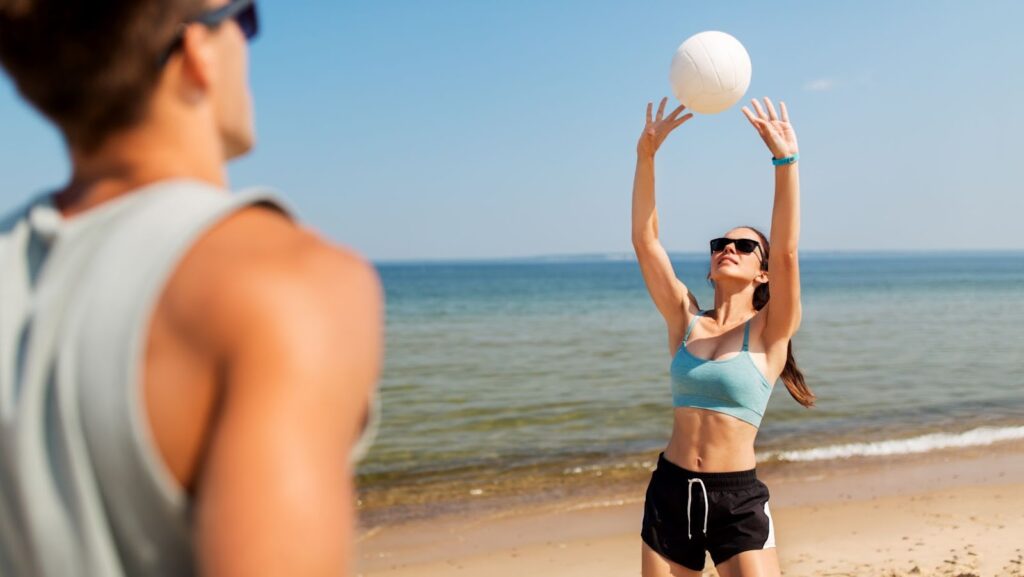The Basics of Beach Volleyball
To master the basics of beach volleyball with the right set of rules and regulations, and equipment requirements are essential. In this part of the article, we discuss the fundamental principles of beach volleyball to get you up and running on the court. Let’s get a closer look at the rules and regulations, as well as the equipment requirements.
Rules and Regulations
Time to hit the beach! Beach volleyball is a game of ethics and principles. Respect your opponents and follow the CEV Code of Conduct. Show up on time and dress properly. No arguing, swearing, or other disrespectful behavior.
You must know the rules. Your team can touch the ball no more than three times without a block. Serve however you like – underhand or overhand. The same CEV Code of Conduct applies to everyone, for a safe and respectful environment.
I fondly recall a match where our team was trailing 14-9. We persevered and won 16-14! Even though we’d lost twice before against the same opponent. A lesson to never give up, no matter the odds.
For beach volleyball, you only need a ball, net, and plenty of sunscreen!
Equipment Requirements
Volleyball is essential for beach volleyball. It needs to be of good quality, with the right pressure. Plus, a sturdy net system set up at the correct height is a must!
Also, you’ll need a court marking kit with boundary lines, centerline, sidelines and service line designs.
It’s important to wear comfortable clothes and footwear that are designed for beach activities. Hats and sunglasses are ideal for protecting eyes from the bright sunlight.
Did you know that volleyball originated as ‘Mintonette’ in 1895? Back then it was just an indoor exercise game. Over time, it evolved into the beach volleyball we know today. Get set to play beach volleyball, and remember: safety first!
Physical Preparation for Beach Volleyball Players
To prepare yourself for beach volleyball with all its challenges, you need to focus on your physical fitness. Importance of Fitness and Training, Developing Agility, and Coordination are all crucial factors to consider for physical preparation. These subsections will cover ways to build strength, endurance, and flexibility, as well as tips to improve your quickness, coordination, and agility.
Importance of Fitness and Training
For beach volleyball players to excel, physical fitness and a strict training regime are a must. A tailored fitness program can help build endurance, strength, flexibility and agility. Through fitness and training, players can improve their performance on the sand and prevent injuries – thus boosting their career prospects.
Regular strength training for core muscles, limbs, and upper body plus cardio exercises like running or cycling are essential. On alternate days, sprints and intense weight lifting can help with muscular endurance and explosive power.
Plyometrics – focusing on fast-twitch muscle fiber contractions – develops power. Flexibility exercises, such as yoga or Pilates, lengthen muscles and improve joint range of motion – reducing injury risk.
Every player should consult a physical trainer who understands the biomechanics of the game to get a personalized workout plan. This not only helps with on-court game play but also reduces overuse injuries, improving performance longevity.
A PubMed Central (NCBI) study found elite male volleyball players had greater bone mineral density in upper femur regions than sedentary individuals. To develop agility and coordination for beach volleyball, try jumping over the sandcastles your opponents build!
Developing Agility and Coordination
Beach volleyball players need to hone their agility and coordination to perform sharp movements like jumping, changing direction, and hitting the ball accurately. Here’s a 3-step guide to help:
- Resistance training with resistance bands. This helps boost muscle strength and flexibility.
- Practicing ladder drills to improve footwork variations and speed of stepping.
- Cone drills to practice quick reflex actions.
It takes time to see significant improvements. According to the FIVB, if a game reaches 21 points per set, two clear points decide the winner. Dig, dive, and dominate! Beach volleyball is more than a sport, it’s a sandy survival strategy.

Beach Volleyball Techniques and Strategies
To master the art of beach volleyball, you need to be well-versed in essential techniques and strategies. In order to help you improve your game and take it to the next level, this section with ‘Beach Volleyball Techniques and Strategies’ with sub-sections ‘Serving and Receiving, Spiking and Blocking’ will provide you with practical insights and tips on how to nail each aspect of the game.
Serving and Receiving
Serving and receiving in beach volleyball are key skills. Precise ball placement and controlled power can make it hard for opponents to return. Check out these tips to ace it!
- Go for an aggressive stance: feet shoulder-width apart, body weight forward, and aligned with the target.
- Hold the ball with both hands, knees slightly bent.
- Toss one hand while using the other to contact the ball’s base when serving.
- For receiving, stand low, legs spread wider than shoulder-width.
- Bend arms, elbows pointing down forming a flat platform when receiving; aim for a clean pass towards your teammate.
Communication is key! Faking shots and changing directions can throw off opponents. Flexibility is essential; adapt techniques based on your opponent’s weaknesses. Wind conditions also affect delivery, so practice regardless of changes and have backup shots. Pro Tip: footwork is key to serving well. Master it and you’ll be unstoppable!
Spiking and Blocking
Synchronization is essential. Blockers must jump before attackers take a swing. Attackers need to predict where the shot will land. Concentrate on the ball’s movements, direction, and speed. Choose your spot wisely to ensure success.
Keep track of progress without an external coach. Practicing these advanced techniques is a must for competitive play. Even smaller bikinis might help distract opponents! Get started now!
Why Do Beach Volleyball Players Wear Such Small Bikinis
To understand why beach volleyball players wear such small bikinis, the present section explores historical context and practical reasons for minimal clothing. This will help you gain insight into the evolution of attire and why certain clothing choices are necessary for optimal performance.
Historical Context and Evolution of Attire
Beach volleyball players have been known to dress in revealing outfits for ages. But the attire has changed into more minimalistic styles. This helps enhance performance while still looking attractive. Standardizing these practices helps create more tournaments. It also removes any sexist links.
Technology, movement range, and modern feminism have all influenced beach volleyball attire. Female athletes feel comfortable in their bodies and clothing choices. So, they now prefer smaller bikinis. It is important to respect the athlete’s choice of outfit as they wear it for comfort and better performance.
Designers offer clothing with broader options. Newer materials protect from the sun and absorb sweat. They also meet safety regulations. This inclusivity allows players from different backgrounds to have an equal opportunity. Athletes should be able to break barriers comfortably and without outdated norms. So why wear shorts when you can just wear a bikini?
Practical Reasons for Minimal Clothing
Beach volleyball players don trendy minimal clothing for practical reasons. The clothes are lightweight and allow for mobility with no hindrance. The bikini also reduces sand build-up that affects performance. It also keeps players from overheating and allows sweat to evaporate quickly.
Plus, it’s fashionable! It accentuates the athletes’ beauty and physique. It spices up the game for fans and spectators.
Other sports, like gymnastics and swimming, have similar clothing designs that promote mobility and comfort during performances.
To truly appreciate beach volleyball, you need to understand its culture. Watching games or viewing them on TV gives a glimpse of its elegance, power, and agility.
Don’t miss this chance to play one of the world’s most exhilarating sports while soaking in nature’s beauty. Why pay for therapy when you can just spike your stress away with beach volleyball?

The Psychological Benefits of Playing Beach Volleyball
To enjoy the psychological benefits of playing beach volleyball with the added bonus of hitting the sand and soaking up sun, jump into the sub-sections titled ‘Stress Relief and Relaxation’ and ‘Social Interaction and Community Building’. These will highlight the advantages of the social and stress-relieving aspects that can be experienced through playing beach volleyball.
Stress Relief and Relaxation
Beach Volleyball can create a calming and relaxing experience, reducing stress. It’s energizing and stimulating, but also refreshing. Plus, it boosts social skills and self-confidence, as it requires teamwork.
Playing on the beach can have psychological benefits like cognitive development and improved mental health. Enjoying nature’s beauty with friends or family can create a moment to cherish.
Kerri Walsh Jennings, an American Beach Volleyball player in the 2008 Beijing Olympics, said playing with something at stake helped her reduce stress and win 3 consecutive gold medals.
In conclusion, Beach Volleyball offers much more than just physical exercise. It stimulates social relationships while providing a fun, sunny experience. It’s like Tinder, but with sand and sweat!
Social Interaction and Community Building
Beach Volleyball offers countless advantages in terms of socialization and community building. Connect with like-minded folks, form positive relationships, and promote communication between players!
- Be part of a shared activity and feel the sense of “belonging”.
- Discuss strategies, provide feedback, and boost your teammates’ morale.
- Broaden your social network and meet new people with common interests.
- Create a community that goes beyond the game and supports each other.
- Foster teamwork, camaraderie, and physical/mental challenges.
Also, beach volleyball is an inclusive environment where respect is highly valued. Get the most out of the experience by volunteering for local tournaments or charity events! Why not make new friends while playing beach volleyball instead of just admiring hot people?
Common Misconceptions About Beach Volleyball
To clear up misconceptions surrounding beach volleyball in “The Joys of Beach Volleyball” guide, focus on gender stereotypes in the sport, and false impressions of the difficulty level of the sport. Learn why beach volleyball players might wear small bikinis.

Gender Stereotypes and Beach Volleyball
Beach volleyball isn’t just for one gender – men and women can both enjoy it! There are no dress codes based on sex, so wear whatever’s comfy. Plus, it doesn’t matter if you’re tall or short – all body types have made it in the sport.
It takes more than athleticism to be great at beach volleyball. You need quick reflexes and good technique to be a pro.
Surprisingly, beach volleyball was only added to the Olympics in 1996. Since then, it’s been gaining popularity – more nations are getting teams and competing!
Misconceptions about the Difficulty Level of the Sport
Beach volleyball is not as easy as many think. The sand makes it more demanding. Plus, two players must work together and have great coordination and communication.
Height and strength can help, but agility and speed are key. You also need good strategies and critical thinking skills.
To be successful, you must stay fit. Eating right and exercising is essential.
You must also be skilled in ball control. Practice drills like setting and hitting can help. Footwork is also important, to reposition quickly during each spike or block.
Beach volleyball is growing, with toned athletes in tight shorts!
Conclusion and Future of Beach Volleyball
Beach volleyball is growing in popularity worldwide and the future looks bright! Its unique blend of athleticism, teamwork and fun has a wide appeal. Investing in tech, research, and outreach will keep it growing.
It’s a great way to stay fit, socialize, and have fun. It welcomes people from all backgrounds and celebrates diversity.
Legend has it that two American entrepreneurs came up with the idea after playing in Santa Monica, California in 1983. Beach volleyball became an Olympic sport in 1996 in Atlanta, Georgia.
Its rich history has led to today’s promising future. Talent has shaped it into a competitive and vibrant sport – seen on global platforms.

